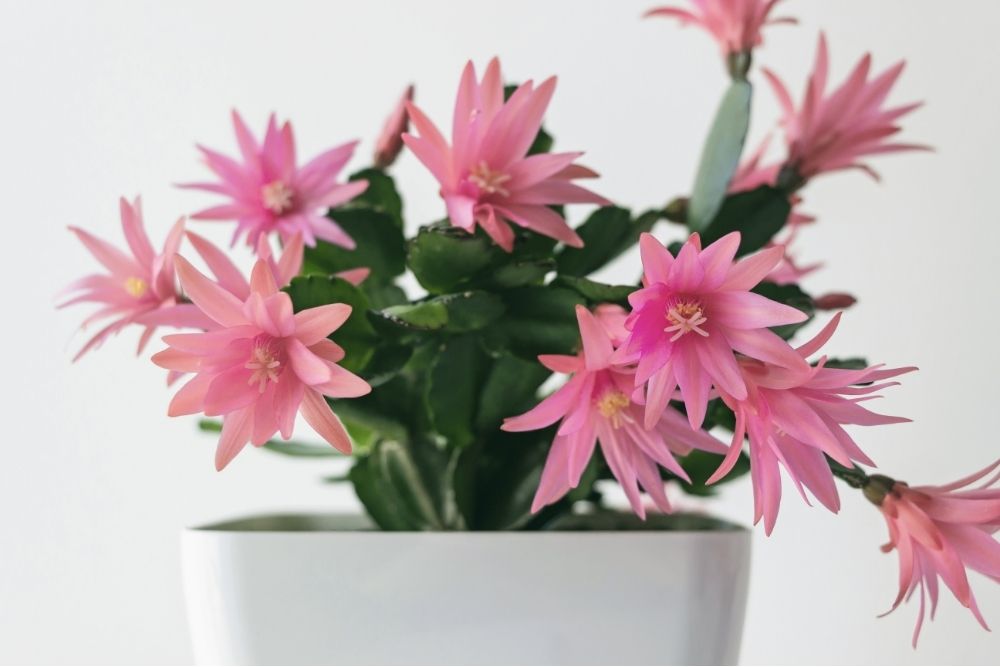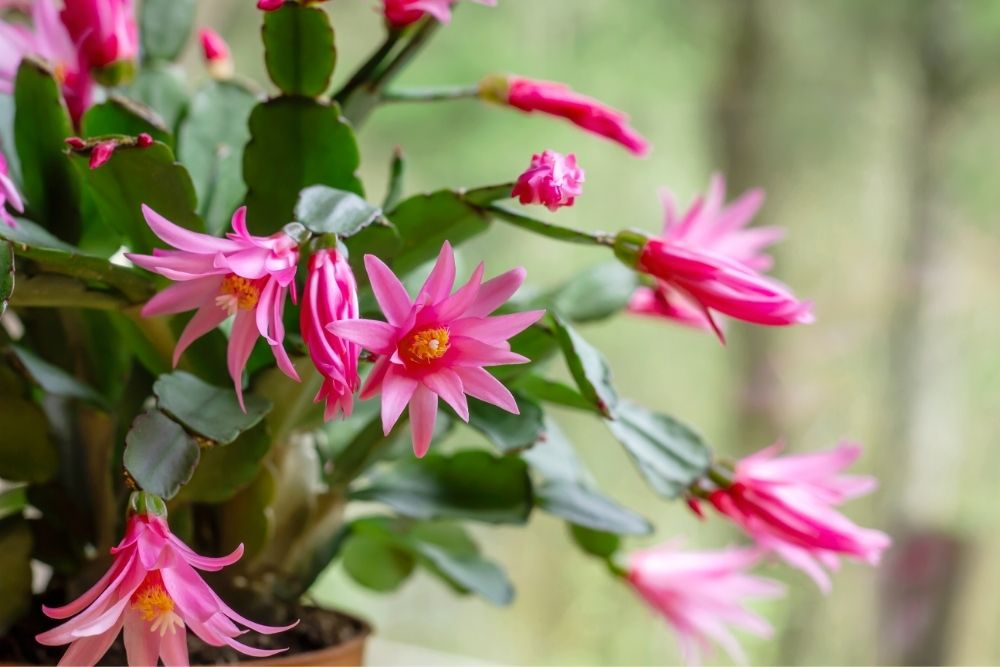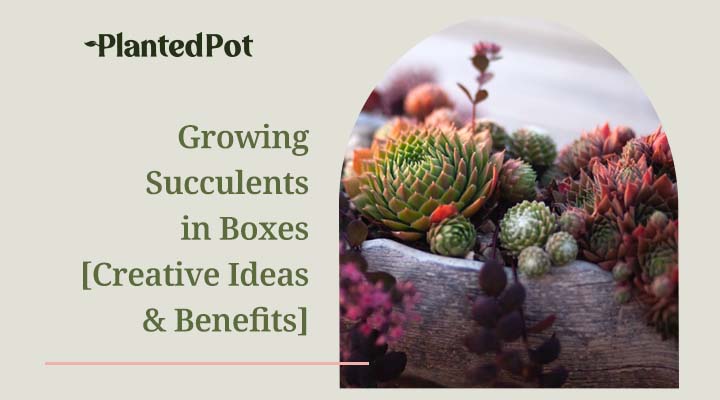
Easter Cactus Care: Essential Tips For Responsible Plant Parents
Home / Easter Cactus Care: Essential Tips For Responsible Plant Parents

Easter Cactus Care: Essential Tips For Responsible Plant Parents
- Zephyr Jaeger
- March 2, 2021
- 8:38 pm
- No Comments
The Easter cactus is a uniquely beautiful tropical plant to care for. Named for its flowering season from the end of winter to the beginning of spring, Easter cacti can be an annual delight if properly tended. Read further to learn more about the resilient yet delicately appealing Easter cactus.
What is an Easter Cactus?
The Easter cactus, scientifically known as the Hatiora gaertneri, is a member of the Rhipsalidopsis tribe. You may also see the Easter cactus referred to as the Rhipsalidopsis gaertneri. Easter cacti originally hail from Brazil, but they grow exceedingly well in the Northern hemisphere.
The Easter cactus is technically an epiphyte – a plant that grows on another plant but isn’t a parasite. In the rainforests of Brazil, Easter cacti grow in the upper stories of the trees! However, they can also grow in certain types of soil and are hailed for being adaptive houseplants.
For most of the year, the Easter cactus is a foliage plant that adds a pop of deep green to your home. Its thick, lush stems grow in oblong segments that have gently serrated edges. For a year or so, the growth is straight upward, but eventually, the stems grow heavy enough to lean over the edges of the pot.
Those stems are technically the leaves of an Easter cactus. Despite their name, they aren’t all that prickly. Easter cactus leaves are smooth, almost plastic-like to the touch. The gently serrated edges aren’t sharp – they’re just shaped in a jagged, easy-going formation.
Although they’re similar, the Christmas cactus (or Thanksgiving cactus) belongs to a different tribe, Schlumbergera. You can tell the difference from the leaves and flowering periods. The Christmas cactus has sharper edges than the Easter cactus, and they bloom at different times of the year.
Is an Easter Cactus Easy to Care For?
Yes, Easter cacti are relatively easy to care for, though they do have a few specific requirements to thrive. Unlike some other houseplants, most cacti actually need to be slightly neglected rather than doted upon. The most common difficulty facing cactus owners is trying not to overwater their plant.
In general, an Easter cactus is an easy houseplant that doesn’t require constant attention. You can sort of set it and forget it, so to speak. As long as you keep to an infrequent yet consistent watering schedule, you shouldn’t have any trouble caring for one of these cheery cacti.

When Are Easter Cacti in Bloom?
The Easter cactus blooms from March through May in the Northern hemisphere, just as the earth begins to warm. The flowers are gorgeous, star-shaped, brightly colored blooms that come in many beautiful shades. Common Easter cactus flower colors are orange, white, pink, purple, and red.
Easter cacti are typically sold at the beginning of their blooming season, right before Easter. The beautiful flowers last through the holiday and then for another month or two before fading away. To get them to bloom again the next year will require a specific, neglectful regimen.
How to Care for an Easter Cactus
The only time-consuming part of bringing an Easter cactus home is setting it up in the right environment. You’ll need to get the right kind of pot, soil, and pick a spot in your home. You’ll also need to nail down a strict watering schedule that won’t overwhelm this plant that prefers dryness.
Finding the Right Pot
For cacti and other succulents, you’re always going to want a porous pot material, such as terracotta. These pots dry out quickly and easily, meaning they won’t retain moisture that could damage your Easter cactus. You can also choose other types of clay pots, but plastic pots aren’t recommended.
RELATED: Christmas Cactus Care: How to Keep Your Cacti Alive & Healthy
When shopping, look for a pot that has drainage holes in the bottom. If you don’t have anything to use as a try underneath the pot at home, look for one while you’re at the plant store. The goal is to allow water drainage out of the bottom, and you don’t want dirty cactus water all over your tables or floors.
Choosing the Right Soil
The Easter cactus prefers a well-draining, cactus-specific soil in order to flourish. You’ll want a sandy soil mix that includes pumice, a lightweight volcanic rock, for these plants. The best soil blend for Easter cacti is about 25% pumice, 25% large-grain sand, 25% garden soil, and 25% bark and twigs.
Pumice is one of the best ingredients in cactus soil because it doesn’t compact over time like regular gardening soil. It maintains the soil’s structure which helps to encourage drainage for months at a time. When filling your pot, try not to pack the soil too tightly – water will need to run through it.
Watering an Easter Cactus
Easter cacti only need to be water every three to six weeks once the soil is nearly completely dry. It’s a bit of a balancing act – you really want to avoid water too soon or too late. To help you keep to a schedule, try adding “water cactus” underneath your reminder to pay a monthly bill on your calendar.
If you think it’s time to water, test the soil with your finger or a toothpick to see if the lower layers are damp. At least the top third of the soil should be pretty dry before you add any water. Keep pouring slowly until you see water coming out of the bottom, then dump the excess water after 10 minutes.
We know it can feel sort of weird to basically neglect a plant for three to six weeks, but keep the cactus’ abilities in mind. They retain water in their fleshy leaves, storing it for several weeks at a time. Even when the soil is beginning to dry out, the Easter cactus has a hidden water supply to keep it alive.
Placement and Lighting
When most people think of cacti, they probably think of the spiky Saguaros that litter the sunny North American deserts. But remember, the Easter cactus isn’t a desert cactus; it’s a rainforest cactus. Easter cacti do not do well in direct sunlight – they prefer bright, indirect light for several hours a day.
To meet the Easter cactus’ lighting needs, avoid placing it on a windowsill or on a table in front of a winder. Instead, place it on a coffee table, kitchen table, or countertop that’s at least a few feet away from windows. This will help to avoid direct light hitting your Easter cactus.
Another tip is to choose a room with north or south-facing windows. This way, the plants will hardly ever experience direct sunlight, even if they are on a windowsill. If you only have east or west-facing windows, do your best to keep your Easter cactus in the middle of the room away from those windows.
Pruning Your Easter Cactus
Easter cacti don’t need a lot of pruning in general – they’re hardy, resilient plants. However, you can trip the tips of the leaves just after their blooming season is over to encourage continued healthy growth. Don’t trim at other times of the year, though, or you may clip off the burgeoning flower buds.
Humidity and Temperature
The Easter cactus prefers a warm environment of about 60 to 75° during the spring, summer, and fall. In the winter, this plant can handle slightly colder temperatures of around 45 to 60°. However, they cannot handle exposure to temperatures below 50° for prolonged periods of time.
As they hail from Brazil’s tropical Eastern rainforests, Easter cacti prefer moderately high humidity of 50 to 60%. The typical household is around 40% humidity, though that fluctuates based on region. If your home is too dry, adding a humidifier can greatly benefit your plant’s health (and yours, too!).
Feeding an Easter Cactus
After the blooming season ends in May, it’s encouraged that you fertilize your Easter cactus about twice a month. Use a liquid fertilizer with a 10-10-10 or 10-10-5 formulation and dilute it to half or quarter strength. An overly-strong fertilizer can overwhelm this type of cactus.
Brush the fertilizer around the base of the plant every two weeks throughout the summer and into the early fall. As the weather begins to cool down, reduce the fertilizing frequency to once a month. When mid-fall comes along, stop fertilizing altogether. This is the start of the plant’s winter rest period which it needs in order to flower again in the early springtime.
When Should I Repot My Easter Cactus?
You can repot your Easter cactus right after the blooming season ends. This can help encourage continued healthy growth just like light trimming can. Begin by grasping the cactus at the base, then flip the pot over and very gently wiggle the plant to get it to come loose.
If it’s not coming loose, run a butter knife along the inner side of the pot, between the wall and the soil. Once it’s out, brush off the old soil and check for root rot. If all looks well, clean your pot with warm, soapy water, refill with a cactus potting mix, and settle your plant back into its revitalized home!

Common Easter Cactus Care Issues
Root rot is the most common care issue with Easter cacti. Root rot is caused by overwatering and water retention that leads to a fungal development under the soil’s surface. If you catch it in time, you may be able to trim the affected roots and save the plant.
Mealybugs can also be annoying cactus pests. You’ll know if your Easter cactus has mealybugs from the cottony material they produce on the leaves. Use rubbing alcohol and a cotton swab to gently rub around the bugs. This will cause them to dry out and fall off of the plant.
RELATED: Coral Cactus Care: How to Grow a Beautiful Frankenplant
How Do I Know if My Coral Easter is Dying?
The Easter cactus should be a rich green color with thick, luscious leaves that grow upward. If you notice the color fading or leaves drooping, that’s a sign that you’re adding too much water. If the leaves are drying out and turning brown, that’s a sign that it’s getting too much sunlight.
Severe cases of root rot can also lead to plant death in many cases. If you go to repot your cactus and notice the roots are soggy, black, and decrepit, that’s a severe case of root rot. In most cases, there’s nothing you can do for a plant whose roots are that far gone.
Related: Coral Cactus Care: 12 Simple Tips for Spectacular Growth
How Do You Save a Dying Easter Cactus?
If your Easter cactus is overwatered but hasn’t developed root rot, cut back on the watering frequenting. You may also want to repot and switch out the soil for a more well-draining mix. If your Easter cactus is getting too much light, move it far away from any windows so it can get a break from the sun.
If your plant is infested with mealybugs and the rubbing alcohol isn’t getting rid of them, keep an eye on the situation. Mealybugs are awful pests that will make their way to your other houseplants if given the chance. If you can’t rid your cactus of them, you may need to toss the plant.
RELATED: Types of Cactus: The Complete Beginner’s Guide to Cacti
Are Easter Cacti Poisonous?
No, Easter cacti are not poisonous to dogs, cats, or humans! These plants make an awesome addition to busy family homes for that reason. Parents don’t need to worry that curious pets or toddlers will take a fatal bite of the leaves, and everyone can take part in the task of getting the plant to flower each year.
Final Thoughts – Easter Cactus Care
If you’re a busy or forgetful person, the Easter cactus is the perfect plant for you. As long as you remember to water and fertilize it about one to two times per month, you’ll be the perfect Easter cactus parent. Bring one home today to brighten your space without stressing yourself over responsibility.



